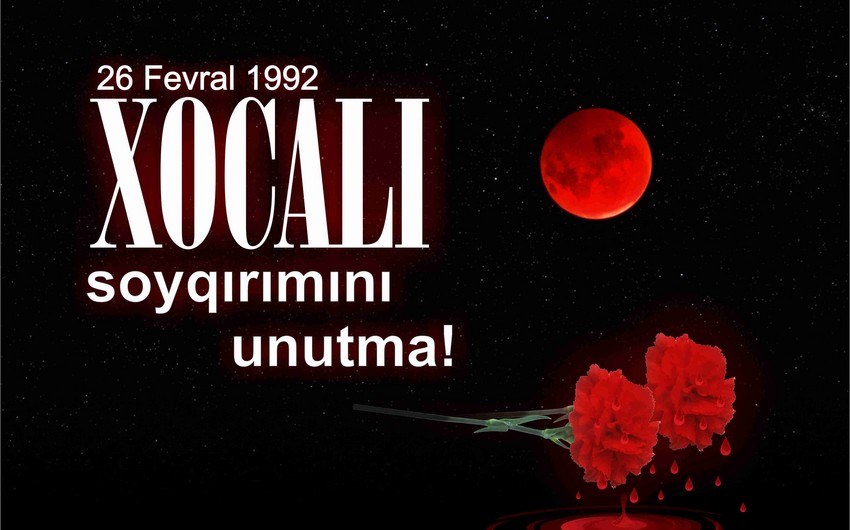Baku. 26 February.REPORT.AZ/ 24 years ago the Khojaly massacre was committed and Khojaly city was occupied by the ethnic ArmenianArmed Forces, reportedly with help of the Russian 366th Motor Rifle Regiment.
Report informs, on the night of February 25th to 26th, 1992, Armenian forces, with the help of the former Soviet 366th Motor Rifle Regiment invaded Khojaly village. The village had been under blockade since October 1991, at which point all roads leading to the city were blocked, and the only available transport was via helicopter. On the evening of February 25 Constant gunfire began. The whole town was on fire at about 5am, 26th February. That was the time when Peaceful inhabitants who fled the town in desperation to save their lives. 2,500 civilians remaining in the village left their territory with the hope to reach Agdam. 613 out of these 2,500 fell victim to enemy fire. As a result of this tragedy, 613 Khojaly civilians were killed in which 63 children, 106 women, and 70 elderly civilians are included. 8 families were completely annihilated. 130 children lost one of their parents, and another 25 lost both of them. 76 out of 487 people wounded by an enemy bullet were children. 1275 Khojaly residents were taken prisoner and 150 went missing. Elman Mamedov, chief of administration in Khojaly, stated that a large group of people who had left Khojaly came under intensive fire from Armenian positions near the village of Nakhichevanik.
Because Khojaly was attacked from three directions, the residents were forced to flee in the direction of Asgaran. Most of the people choose two directions to flee from Khojaly from the eastern side of the town in the north-east direction along the river, passing Askeran to their left, from the northern side of the town in the north-east direction, passing Askeran to their right. Thus, the majority of civilians left Khojaly, while around 200–300 people stayed in Khojaly, hiding in their houses and basements. As a result of the shelling of the town, an unascertained number of civilians were killed on the territory of Khojaly during the assault.This was revealed to be part of an Armenian strategy. The fleeing villagers were stopped by Armenian forces near Nakchevanik village and shot down. Exhausted after travelling through snowy mountains and woods, the villagers were cruelly killed by Armenian armed units on the Asgaran-Nakchevanik plain. On March 1st local and foreign journalists witnessed more cruelty. The dead were mutilated - scalped or burned, their ears and other body organs were cut off, their eyes were removed, they had suffered multiple bullet and bayonet wounds. Some had been taken aside and shot separately; many had been killed as entire families at once. Some corpses displayed several wounds, one of which was invariably in the head, suggesting that the wounded were executed. Some children were found with severed ears; the skin had been cut from the left side of an elderly woman’s face; and men had been scalped. Children were tortured and killed in front of their parents; and two Azerbaijanis had their eyes taken out with screwdrivers. But this was not the end of brutal story.
The site of the mass killing of Khojaly inhabitants was filmed on videotape by Azerbaijani journalist Chingiz Mustafayev. He was accompanied by the Russian journalist Yuri Romanov during the first helicopter flight to the scene of the tragedy. Romanov described in his memoir how he looked out of the window of the helicopter and literally jumped back from an incredibly horrible view. The whole area up to the horizon was covered with dead bodies of women, elderly people and boys and girls of all ages, from newly born to teenagers. From the mass of bodies two figures caught his sight. An old woman with uncovered gray head was lying face down next to a small girl in a blue jacket. Their legs were tied with barbed wire, and the old woman’s hands were tied as well. Both were shot in their heads, and the little girl in her last move was stretching out her hands to her dead grandmother. Shocked, Romanov even forgot about his camera, but after recovering from the shock started filming. However, the helicopter came under the fire, and they had to leave.
In 2012, the Pakistani Senate passed a resolution condemning the genocide of civilians in Khojaly. Romania, Mexico, Columbia, Check Republic, six states of the USA, Canadian province of Alberta, OIC and Non Aligned Movement introduced resolutions recognizing Khojali genocide. This issue was subject of discussions and strong condemnation in the Parliaments of Turkey, Netherlands, Belgium, Canada, Germany, Italy, Council of Europe , European Union.
So far, the Khojaly tragedy was recognized as a genocide by Mexican Senate, Pakistani Senate`s Foreign Relations Committee, Columbian parliament, as well as house of representatives of the US State of Massachusetts, States of Texas, New-Jersey and Georgia.
Khojaly genocide victims are commemorated every year in Azerbaijan and other countries with deep mourning. Azerbaijani embassies and Diaspora organizations organize commemoration ceremonies demonstrating photos, documentaries which describe truth about genocide in Khojaly.
“Justice for Khojaly" campaign was started in February of 2009 on the initiative of the General Coordinator for Intercultural Dialogue of the Islamic Conference Youth Forum for Dialogue Leyla Aliyeva. The purpose of the campaign is to inform the international society about Khojaly tragedy, provide moral-political assessment of the tragedy in the international arena and commemoration of it at the international level.
Considering the necessity of "Justice for Khojaly", which are helding at international level in 40 countries of the world, Azerbaijani President Ilham Aliyev signed an Order "On measures of provision 'Justice for Khojaly' campaign" on 13 February, 2014.
At the moment, internally displaced persons (IDPs) from Khojaly temporarily placed at 50 cities and regions of Azerbaijan.


 https://static.report.az/photo/76b5261a-7085-44f1-b76c-5bb2709278d2.jpg
https://static.report.az/photo/76b5261a-7085-44f1-b76c-5bb2709278d2.jpg

